Archive for the ‘Methodology’ Category
Tuesday, February 27th, 2024
“Nothing happens unless first we dream.”
— Carl Sandburg
Today’s featured artwork is a studio collage landscape inspired by a dream and finished from imagination. I believe it was triggered by a combination of time spent outside observing earth, sky, and water, with the natural reservoir of so-called talent cultivated from childhood.
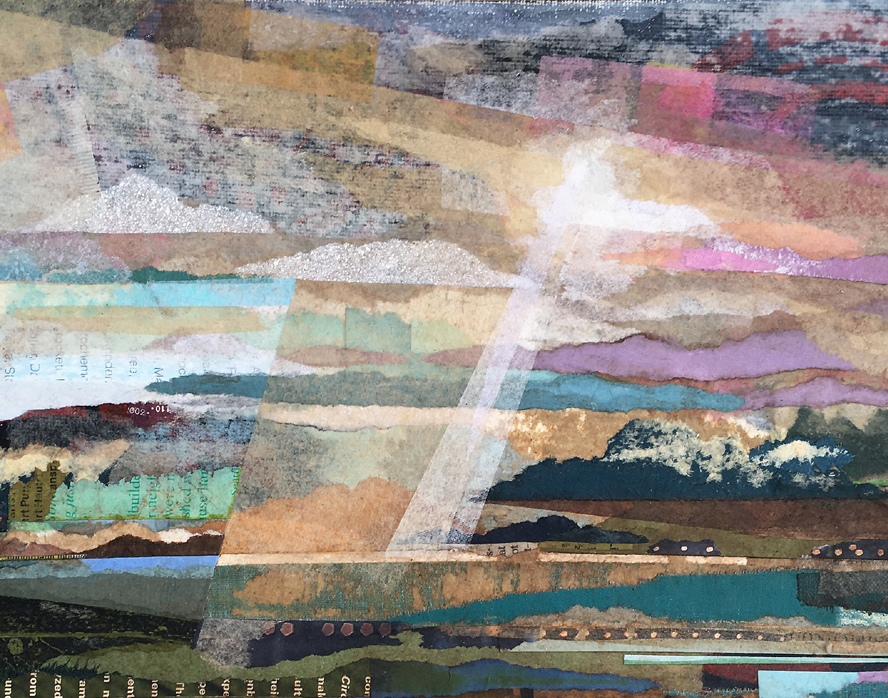 Dream-inspired images are rare creatures for me, but I grab one when it emerges. More often than not, my waking imagination falls short when trying to capture it. Over the years, I’ve had more success in that line coming up with graphic design concepts than I have with artistic impressions. It probably has something to do with how my subconscious responds to an explicit problem-solving setup, in contrast to more undefined visual images (which in my dreams tend to be preposterously complicated and nearly impossible to retain).
Dream-inspired images are rare creatures for me, but I grab one when it emerges. More often than not, my waking imagination falls short when trying to capture it. Over the years, I’ve had more success in that line coming up with graphic design concepts than I have with artistic impressions. It probably has something to do with how my subconscious responds to an explicit problem-solving setup, in contrast to more undefined visual images (which in my dreams tend to be preposterously complicated and nearly impossible to retain).
As happened when I shared this image elsewhere, I have often received the remark, “You’re so talented.” Many artists have heard this, too, and would relate to my mentioning it. I usually respond by saying something like this: talent alone goes stagnant early on if an individual doesn’t develop it with a life of effort and follow through. I appreciate what these people mean and their sincere intent to praise, 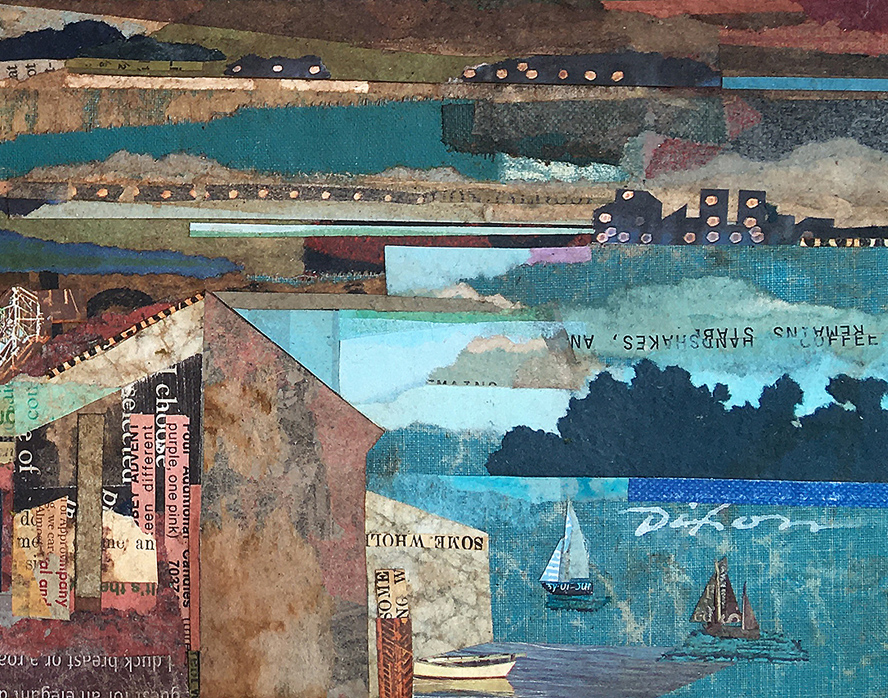 but they usually don’t grasp the full picture. A refined trust in intuition is often mistaken for talent, but actual talent is a creation of the Universal Source. Artistic talent, intellectual talent, empathic talent, athletic talent — there is no difference, because we all get our start with some kind of talent as a divine inheritance. For some of us, it might’ve been more obvious (especially if we liked to show off for others). How many “talented” young athletes are age-group champions into later life? How many “talented” young musicians or dancers become professional performers with the respect of their peers? There you have it. Any talent can be lost without the effort and stick-to-it mindset that overcomes challenges and builds effective skills and attitudes. And make no mistake about it — such acquired discipline comes from God, too, so let’s give proper credit and keep working!
but they usually don’t grasp the full picture. A refined trust in intuition is often mistaken for talent, but actual talent is a creation of the Universal Source. Artistic talent, intellectual talent, empathic talent, athletic talent — there is no difference, because we all get our start with some kind of talent as a divine inheritance. For some of us, it might’ve been more obvious (especially if we liked to show off for others). How many “talented” young athletes are age-group champions into later life? How many “talented” young musicians or dancers become professional performers with the respect of their peers? There you have it. Any talent can be lost without the effort and stick-to-it mindset that overcomes challenges and builds effective skills and attitudes. And make no mistake about it — such acquired discipline comes from God, too, so let’s give proper credit and keep working!

Wind Harbor
collage on canvas panel by J A Dixon
studio landscape from dream / imagination
14 x 11 inches
available for purchase
Posted in 1) Available!, Collage, Details, J A Dixon, Landscape, Methodology, Music | No Comments »
Tuesday, November 21st, 2023
“Accepting the familiar is the enemy of seeing… Seeing takes work and patience and concentration and focus otherwise we are always walking around in a fog only seeing what we think we know but not actually seeing anything at all.”
— Cecil Touchon
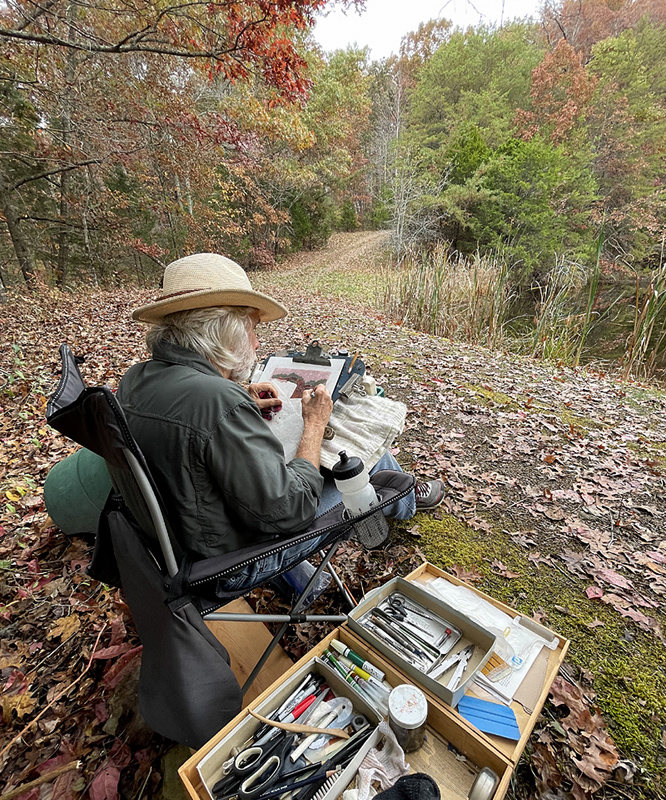
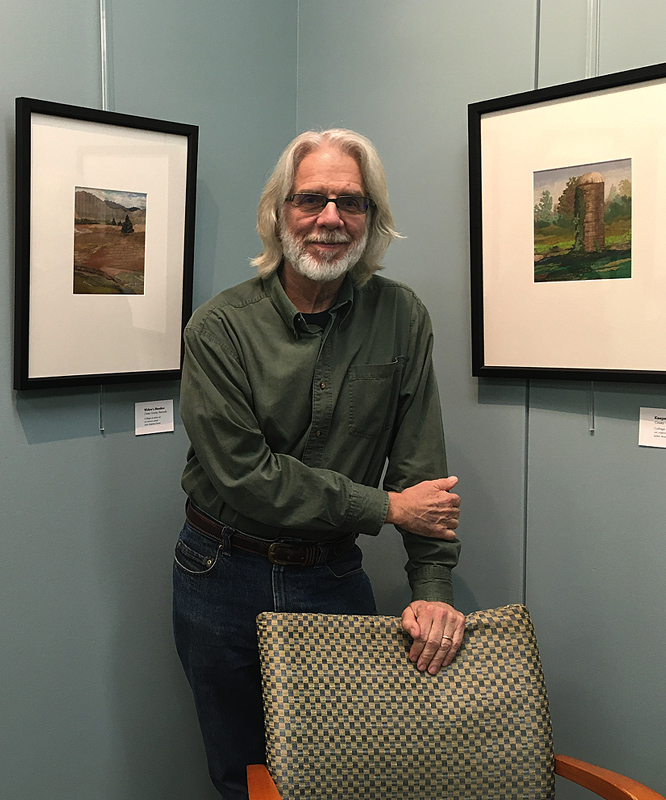
Although I have worked outside at entirely wild places (river palisades, for example), I seem to be drawn more to locations that have been cared for by others. To truly observe a rural setting and interpret it with found paper as a collage landscape, I need to spend hours slowing down my busy mind. I approach a kind of reverence for it as a place of evident stewardship and quiet beauty. It’s a slow-motion form of rapt attention, and I am able to see it as a fusion of natural creation with human affection. LITTER-ALLY KENTUCKY is the result.
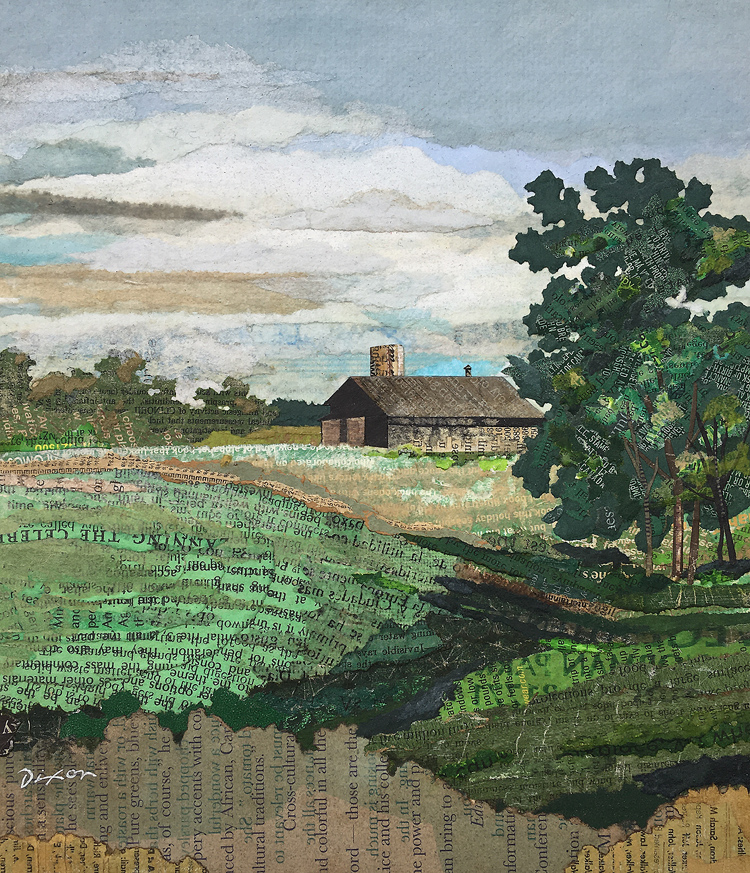
Her Brother’s Barn
Boyle County, Kentucky
collage en plein air by J A Dixon
8 x 9.3125 inches
16 x 20 inches, framed
giclée print available
Posted in En Plein Air, Exhibitions, J A Dixon, Landscape, Methodology | No Comments »
Monday, February 13th, 2023
In order to preserve more time for the completion of plein-air landscapes, it’s necessary to reduce the Februllage series, and so I’ve started “doubling up” on the catalyzing prompts. Apparently the impetus for Merz has been formulating for awhile. The classical methodology can dominate my workload if permitted. So far, this series has been a stimulating experiment with distinctly surreal tones. It’s interesting to notice a boost in manual dexterity when I increase the pace of intuitive assembly. Instead of getting “sloppier,” I tend to tighten up and attune to mechanical and compositional precision, even as the juxtapositions become more illogical. I never run out of steam with this medium.
Such a splendid blend of craft and psychological dynamics!
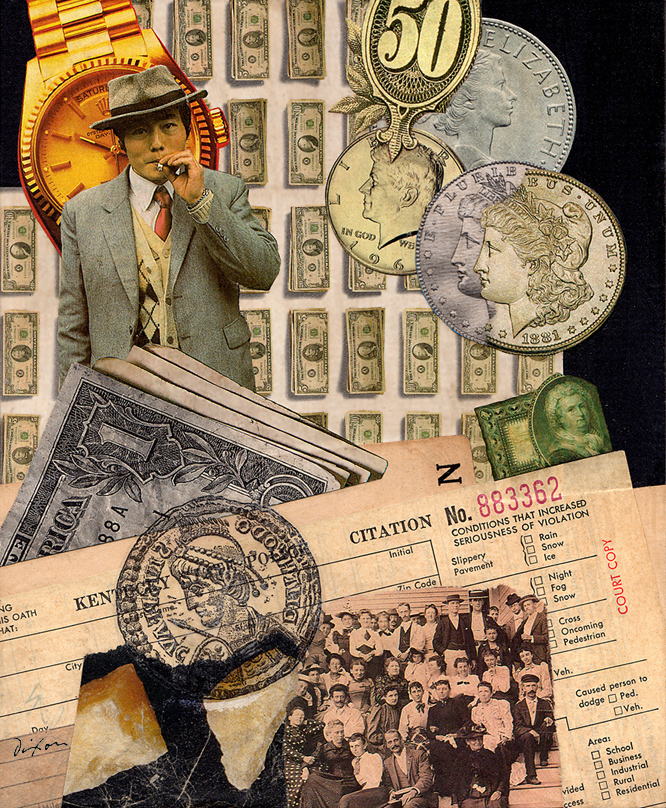

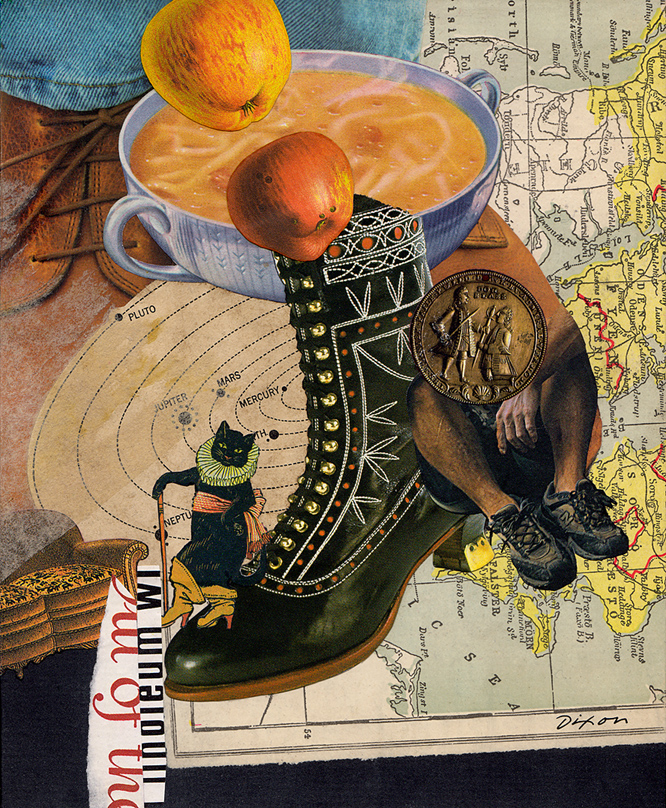

Posted in Collage, Constraints, Februllage, J A Dixon, Methodology, Surrealism, Technique, The Lived Life Series | No Comments »
Saturday, February 19th, 2022
“Follow the ways of natural creation, the becoming, the functioning of forms, then perhaps starting from nature you will achieve formations of your own, and one day you may even become like nature yourself and start creating.”
— Paul Klee
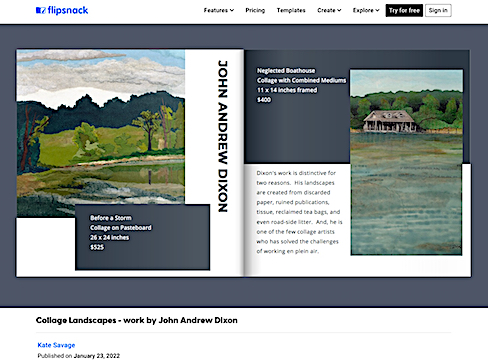 As I pushed toward the hanging date for CHANGE OF SEEN last month, I pulled out an unfinished work. In 2020 it had been my hope to complete it as part of the Paint By Nature entry — an interpretation of an urban oak tree. Everything was done except for the tree itself, which I’d wanted to paste together in a burst of spontaneity. The “start” went into cold storage when I ran out of time for two submissions. Fast forward to January 2022. Now I had the ideal scenario. My tight deadline would not allow me to indulge any slowdown or second guess. Positive, unanticipated things often happen when I occasionally challenge myself to work under a severe constraint. The hesitant, rational mind is sidelined in favor of an intuitive response that is rooted in everything one has ever created. This can be the case with music, writing, or nearly any artistic format, but the phenomenon especially lends itself to painting.
As I pushed toward the hanging date for CHANGE OF SEEN last month, I pulled out an unfinished work. In 2020 it had been my hope to complete it as part of the Paint By Nature entry — an interpretation of an urban oak tree. Everything was done except for the tree itself, which I’d wanted to paste together in a burst of spontaneity. The “start” went into cold storage when I ran out of time for two submissions. Fast forward to January 2022. Now I had the ideal scenario. My tight deadline would not allow me to indulge any slowdown or second guess. Positive, unanticipated things often happen when I occasionally challenge myself to work under a severe constraint. The hesitant, rational mind is sidelined in favor of an intuitive response that is rooted in everything one has ever created. This can be the case with music, writing, or nearly any artistic format, but the phenomenon especially lends itself to painting.
Interestingly, I’ve always preferred watercolors to other paint mediums because of its unpredictability and the “happy accidents” that occur. I admire oils greatly, but they hold no attraction for me as I approach my 70s. I hadn’t expected to discover that “painting in papers” could captivate me so and knit a reverence for nature into my art. 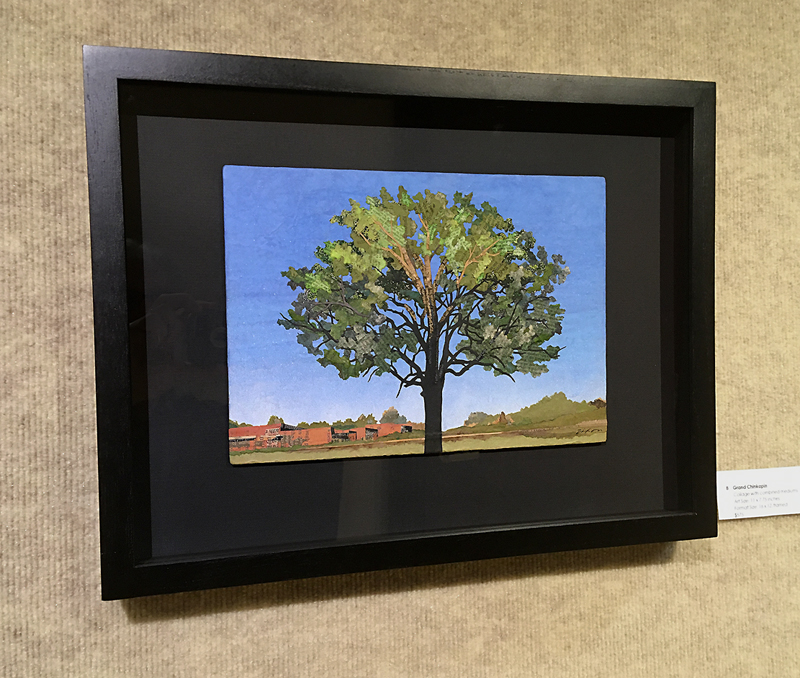
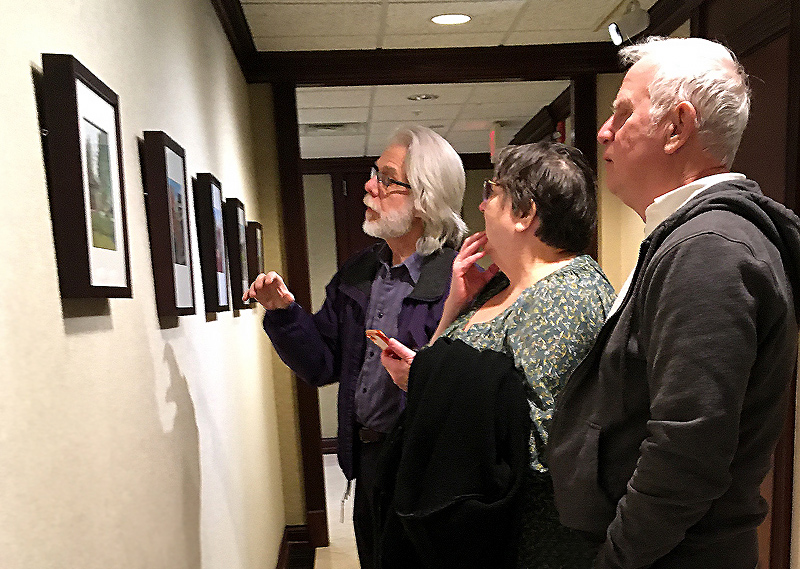 One of the primary appeals of collage is total flexibility. It’s almost impossible to make a blunder, if one stays “in the zone” without letting the intellect gain an upper hand. When others use words such as exacting or meticulous to describe what I do, it usually throws me, because I consider my approach as more instinctive. And yet, there is no denying the presence of “artisanship.” With any task at hand, craft is essential. It was drilled into me with rigor after I chose the path of applied design. (That the young are asked to dedicate themselves to a particular discipline and to ignore countless alternatives is a weird fact of life. Many of us spend decades unraveling it.) So, a certain precision is fused into my method, even when I’m racing the clock. One man’s chaos is another man’s perfectionism.
One of the primary appeals of collage is total flexibility. It’s almost impossible to make a blunder, if one stays “in the zone” without letting the intellect gain an upper hand. When others use words such as exacting or meticulous to describe what I do, it usually throws me, because I consider my approach as more instinctive. And yet, there is no denying the presence of “artisanship.” With any task at hand, craft is essential. It was drilled into me with rigor after I chose the path of applied design. (That the young are asked to dedicate themselves to a particular discipline and to ignore countless alternatives is a weird fact of life. Many of us spend decades unraveling it.) So, a certain precision is fused into my method, even when I’m racing the clock. One man’s chaos is another man’s perfectionism.
I’ve lived my adult life trying to spin creative gold in a studio of one sort or another. A supremacy of the natural world in my youth had been set aside as part of an itinerary toward the graphic arts profession. Reflecting on a long journey that leads to the ever-rolling “now,” I recognize that nature was always calling. It influenced my leaving big cities for a smaller community. It provided a firm foundation for my diet and a health-oriented lifestyle. It was an unfailing source for well-being when conditions seemed out of balance. Even so, an unsatisfied need remained elusive until I finally took paper and paste outdoors, where the potential for inspiration was out of arm’s reach. That I could respond with collage, and find it so rewarding, is something I hadn’t foreseen.
If you want to start with the first chapter, you can find that story here. It’s been almost five years of direct observation, and I’m itching to begin a new season of working en plein air. The broader point I’d like to make is how the experience also has invigorated the way I approach representational collage in the studio. It feels like it’s all been funneled into an evolving intuition. Working outside has transformed how I make visual decisions even when using photographic reference under pressure, as I did with Grand Chinkapin. After quickly preparing piles of printed scrap that seemed appropriate for tree foliage, I was able to explode those ingredients into place with a minimum of conscious thought — not unlike I try to do every time I take my collage kit on location. “Painting from nature with paper” has become a more integrated practice, inside or outside. Change of Seen shares this adventure with others.
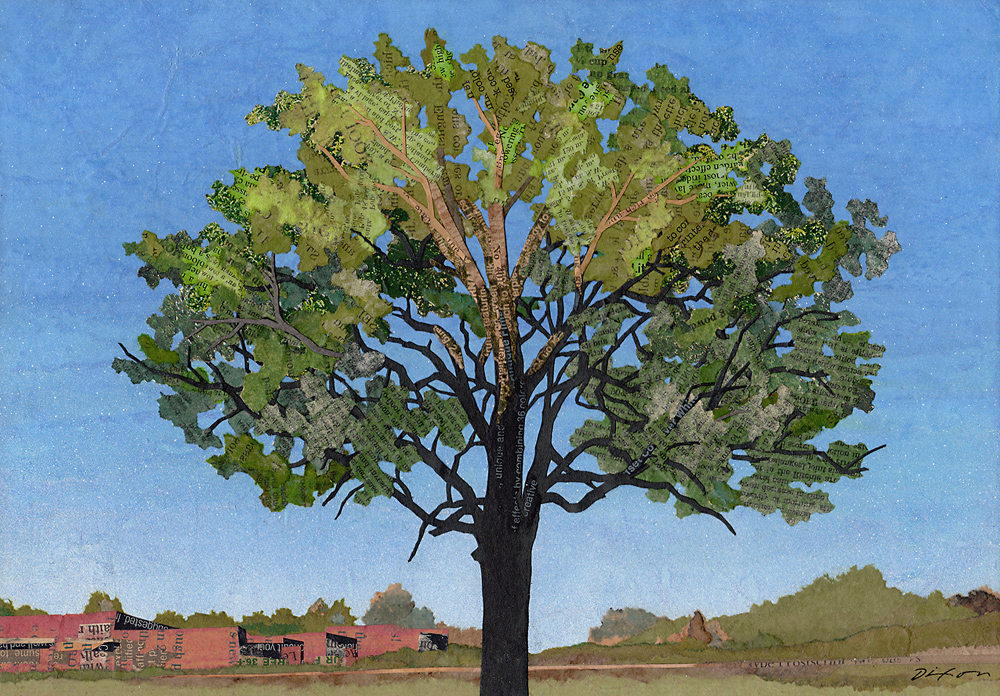
Grand Chinkapin
collage with combined mediums by J A Dixon
0% / 100% — site to studio
11 x 7.75 inches + shadow-box frame
available for purchase
Posted in 1) Available!, Acrylic, Collage, Combined Mediums, Constraints, En Plein Air, Exhibitions, Ingredients, J A Dixon, Landscape, Methodology, Music, Watercolor | No Comments »
Monday, October 11th, 2021
“We think of the things we own and use as defining us in some way, but that can only be true if we first describe the things. Describing is a remarkable human act. It connects our inner and outer experience: as we observe and record the material world, we respond and reflect. We enter the realm where the material world meets the imagination. That’s the fertile ground of art.”
– Sheldon Tapley
I created this artwork for The Object Seen: Contemporary Still Life, current exhibition at Art Center of the Bluegrass in Danville. The juror was Sheldon Tapley, masterful painter, draftsman, and Stodghill Professor of Art at Centre College. I received a 2nd-place ribbon and cash prize. 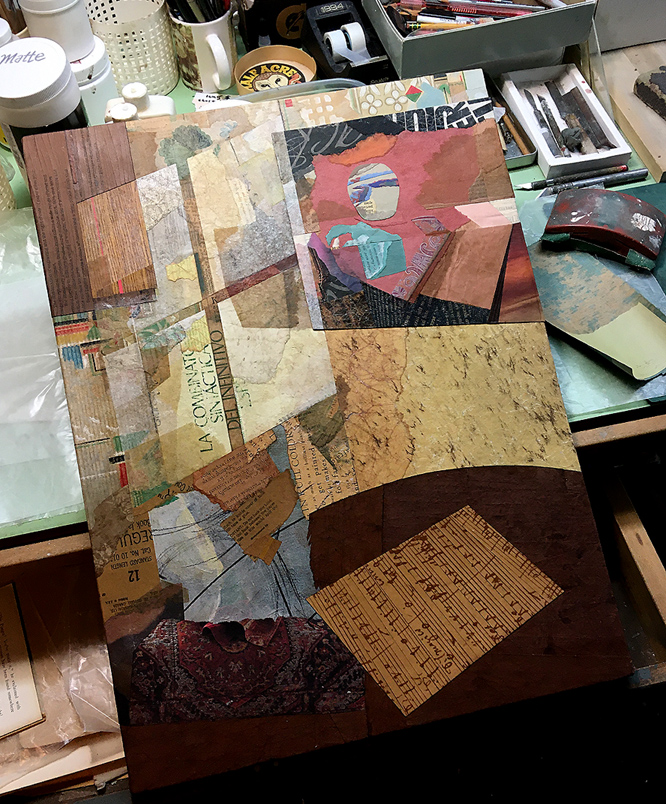 The honor came as a surprise, since I don’t consider myself a practitioner or student of still life as an art form. I have, however, looked deeply at artwork made by Sheldon and those who are. The arms-length quality of modern still life has compelled my close scrutiny for many years. Given that influence, I brought to the genre what I’ve discovered by “painting in papers” from direct observation (the long sweep of art history hovering somewhere outside my conscious awareness, with its rich tradition of artists tackling visual cornacopias of objects and edible fare). I decided to interpret a tabletop group of objects from raw material, rather than assemble a conventional collage composition from found images.
The honor came as a surprise, since I don’t consider myself a practitioner or student of still life as an art form. I have, however, looked deeply at artwork made by Sheldon and those who are. The arms-length quality of modern still life has compelled my close scrutiny for many years. Given that influence, I brought to the genre what I’ve discovered by “painting in papers” from direct observation (the long sweep of art history hovering somewhere outside my conscious awareness, with its rich tradition of artists tackling visual cornacopias of objects and edible fare). I decided to interpret a tabletop group of objects from raw material, rather than assemble a conventional collage composition from found images.
Please view a video clip of the juror’s remarks about my artwork.
The peony tulip blossoms were created en plein air in a local flower garden. The small “still life within a still life” was commenced and partially finished from a setup of actual objects. I relied on photo reference for the rest. Ingredients include colored paper (printed and unprinted), wallpaper, ruined book parts, tissue, reclaimed tea bags, string, and a dried leaf, plus minimal use of walnut juice, burnt coffee, tinted paste, and marker-ink edging. Adhesives include wheat paste, acrylic matte medium, and white glue.
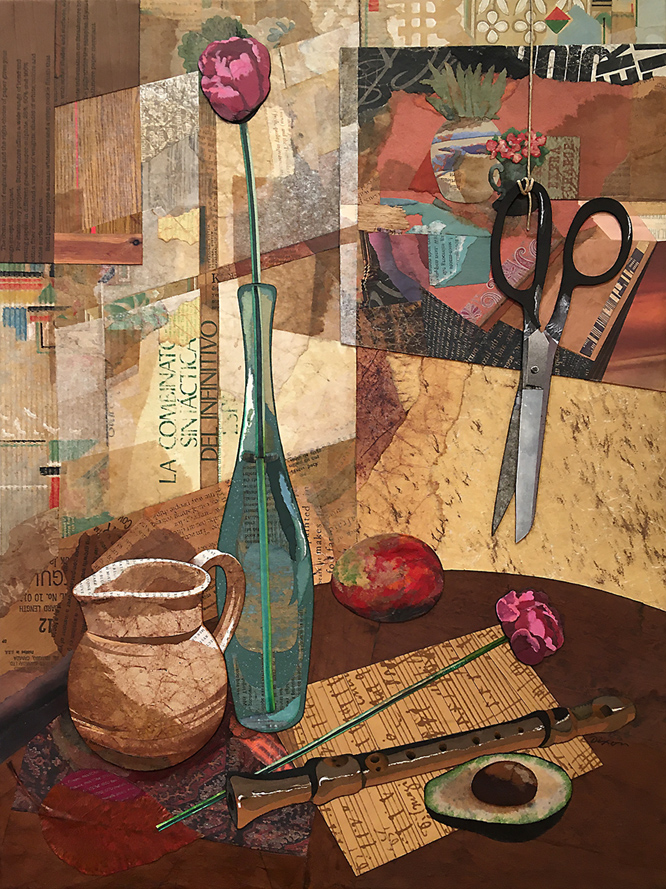
Still Life with Peony Tulips
collage on salvaged canvas
18 x 23.75 inches
• Second Place Prize
Posted in 1) Available!, Collage, Cubism, En Plein Air, Exhibitions, Honors, Ingredients, J A Dixon, Larger Works, Methodology, S Tapley, Still Life, Technique | No Comments »
Saturday, July 3rd, 2021
“If everything seems under control, you’re just not going fast enough.”
— Mario Andretti
One week ago, I spent a windy Saturday in frantic competition with the clock, and managed to get an outdoor collage artwork framed and delivered for Lexington’s annual Paint the Town plein air event. At the opening reception that same evening, I was stunned to get a prompt sale and 2nd-place prize. It was one of the most exhilarating twelve hours I’ve experienced in quite a while.
Oh, the dubious lengths some of us will go to chase artistic intensity — even the temporary madness of extreme deadline pressure — all in the pursuit of rapt spontaneity. Heaven help me!
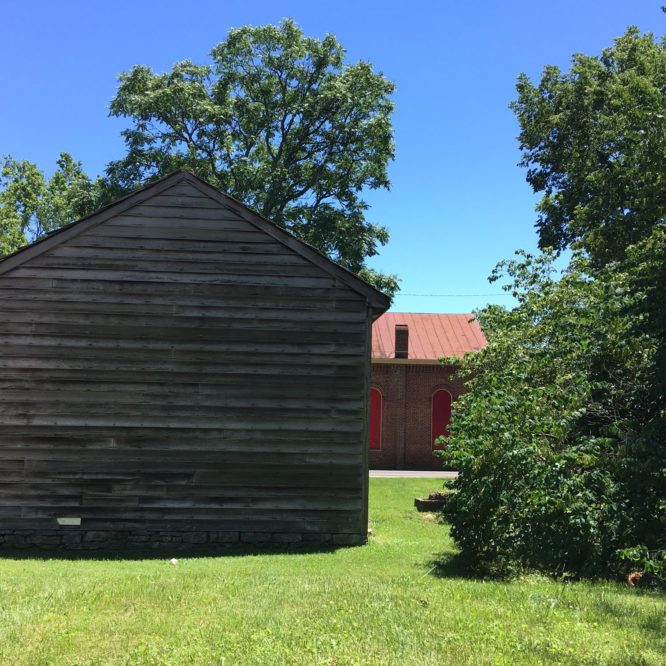
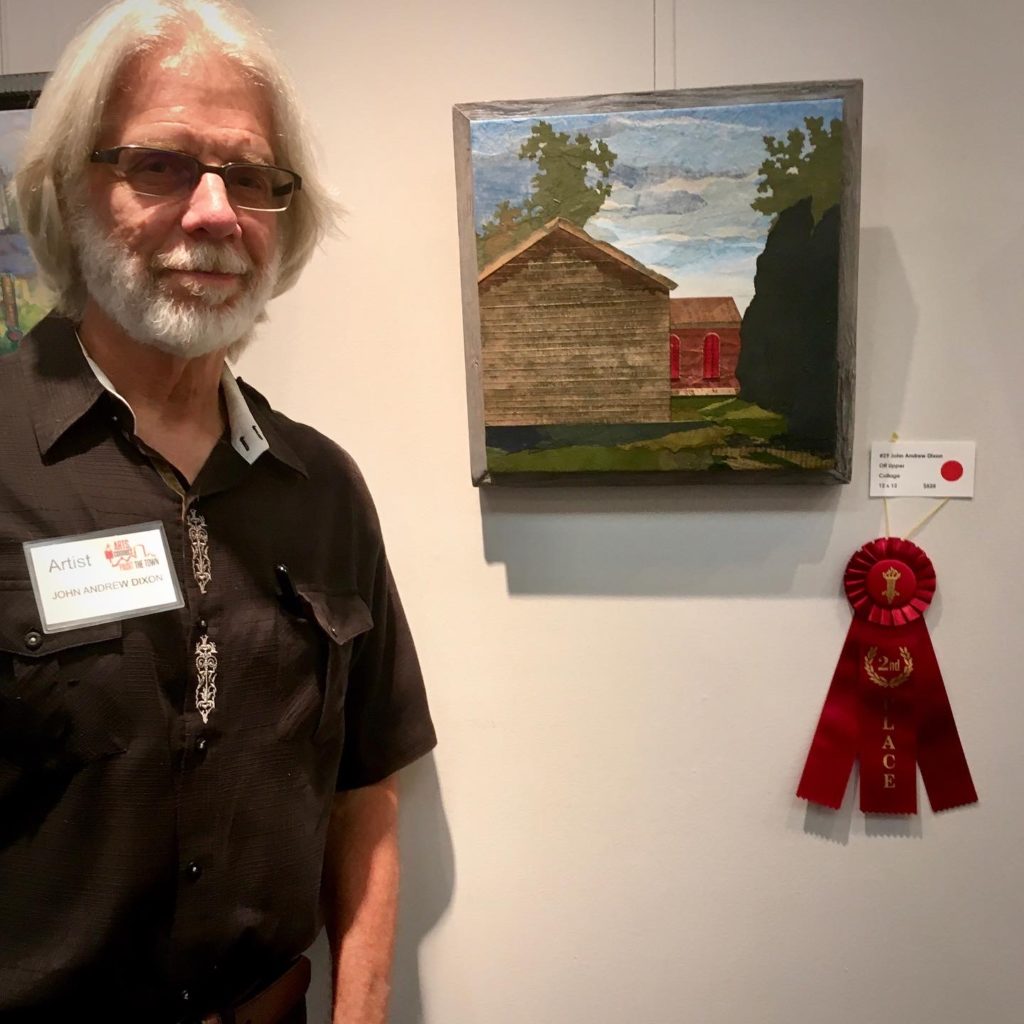 It doesn’t seem so long ago when I first took my collage obsession out of doors, and this kind of open challenge was a goal too absurd to contemplate. I had scouted the location and spent a couple days in preparation. By the time I’d registered a blank canvas, raced to my site and set up, one of the precious six hours had evaporated. I began to battle the breeze (nothing new there). Nor were the other 40 artists involved my foes. It was clear that the only towering opponent I faced was a daunting imperative to speed up my process. I’ve never pasted paper so fast in my life!
It doesn’t seem so long ago when I first took my collage obsession out of doors, and this kind of open challenge was a goal too absurd to contemplate. I had scouted the location and spent a couple days in preparation. By the time I’d registered a blank canvas, raced to my site and set up, one of the precious six hours had evaporated. I began to battle the breeze (nothing new there). Nor were the other 40 artists involved my foes. It was clear that the only towering opponent I faced was a daunting imperative to speed up my process. I’ve never pasted paper so fast in my life!
The judge said this about my piece: “I was very interested in the way this artist managed to create such an evocative landscape using collaged paper — and on a windy day! Places and buildings often hold so many memories and meanings, and the use of text on the siding of the buildings — with the words appearing in reverse, so they become texture and tone — adds another level of meaning.”
It’s gratifying, and profoundly reinforcing, to have a knowledgeable evaluator find significance in aspects that have evolved gradually to become a natural part of my plein air method. I appreciate her remarks, the organizing effort of all those with Arts Connect, the camaraderie of the participating artists, the buyers (Scott and Paul), the indispensable support of my dearest partner — and you, reader, for visiting here and for reading all of this!
Onward to the next challenge!
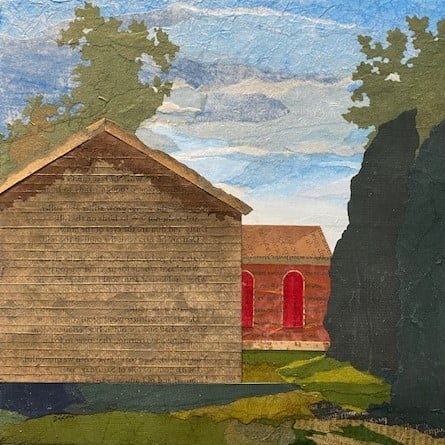
Off Upper
plein air collage on canvas by J A Dixon
12 x 12 inches
• Second Place Prize / S O L D
Posted in Collage, Constraints, D L Dixon, En Plein Air, Events, Exhibitions, Honors, Ingredients, J A Dixon, Landscape, Methodology, Technique | No Comments »
Friday, May 28th, 2021
“Younger than we are,
O children, and frailer,
Soon in the blue air they’ll be,
Singer and sailor.”
— Nest Eggs | A Child’s Garden of Verses,
Robert Louis Stevenson, 1900
Today is the final day of “New Birth, New Growth, New Beginnings,” a juried exhibition celebrating spring at Art Center of the Bluegrass. My accepted artwork originated from a satisfying blend of subject, medium, and poetic reference.
The green space that surrounds my home studio has been a haven for multiple generations of robins. A surreptitious, close-up glimpse of their familiar nest eggs was the visual idea that dislodged any others I might have used to interpret the theme. Spring is my favorite time of year, as it is for many, and perhaps the finished piece captures how my imagination is charged with anticipation for nature’s annual season of renewal. There is also something about the chaotic order of a bird’s nest that ideally lends itself to collage ingredients. I wanted to include the textural patterns of printed text, along with actual organic substance — in this case, the inner membranes of hard-neck garlic stalks from the previous year’s harvest. The “patina” of salvaged wallpaper from a nearby historical tear-down provided areas of desired subtlety. Relying on reclaimed tea-bag material has gradually become an integral part of my technique, but I hadn’t put it to use before with such a linear quality. For zones that would benefit from deeper shadow, I added walnut juice to my typical polymer sealant and “smoothed” the eggshells ever so slightly with colored pencil and a milky tint (giving rise to the final description of “combined mediums”).
Human civilization has increasingly peeled itself from the balanced interdependence of the natural world. More of us are doing our best as individuals to fix that torn relationship. There are different ways to promote a necessary restoration. It’s important to discover as many as possible. I find myself taking more advantage of bringing art to nature and nature to art. I am thankful that my life conditions grant me creative opportunities to experience this healing process.
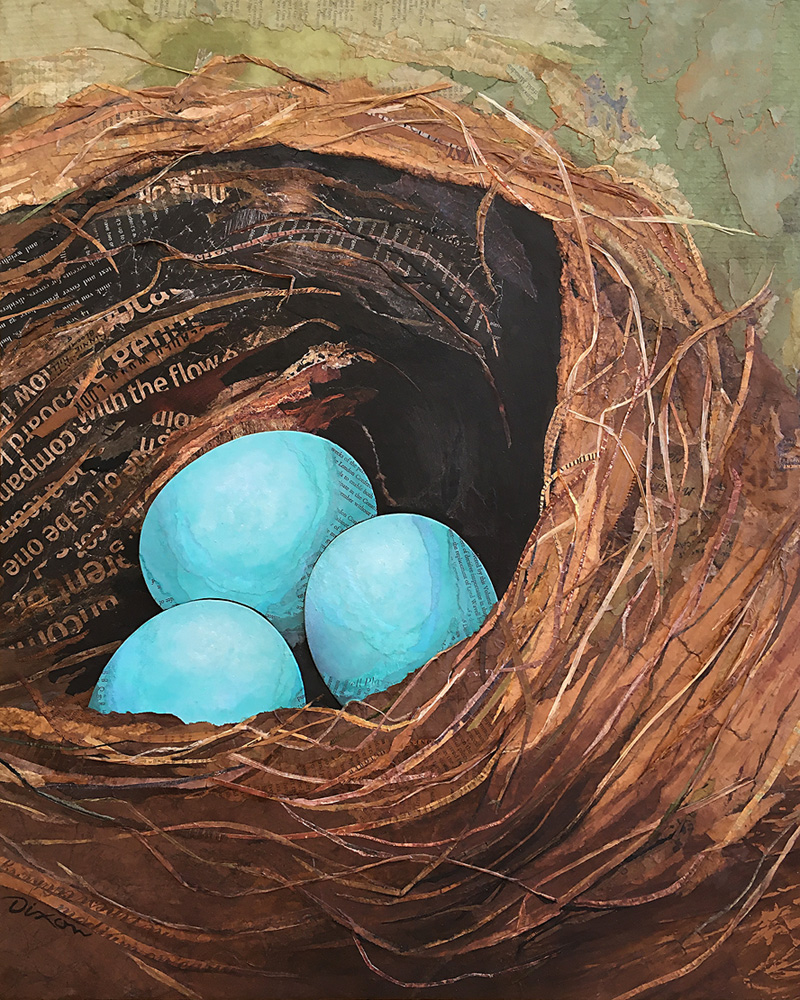
Soon in the Blue Air They’ll Be
collage with combined mediums on structured panel
J A Dixon, 20 x 25 inches
• S O L D
Posted in Acrylic, Collage, Combined Mediums, Exhibitions, Ingredients, J A Dixon, Larger Works, Methodology, Pencil, Technique, Verse | No Comments »
Sunday, January 31st, 2021
“Great performers focus on what they are doing, and nothing else…They let it happen, let it go. They couldn’t care less about the results.”
— John Eliot
“When we are no longer able to change a situation, we are challenged to change ourselves.”
– Viktor E Frankl
Completion brings varied doses of relief, disappointment, astonishment, regret, and pride. To sort them out, it is beneficial to self-assign the task of tight scrutiny while a measure of internal evaluation is front of mind. It is sometimes interesting to experience a perceptible transition from “hate it” to “that ain’t bad” — or from “wow, cool” to “perhaps if I had instead.”
With Synthesis, I found that I didn’t need for a state of high criticism to slowly diminish. This time around, a sense of broad satisfaction could not be denied. Even so, I undertook my customary ritual of zoomed-in photo crops, looking for strengths and weaknesses before the full aura of the creative process had faded. The handy smartphone camera makes for an uncomplicated post-mortem examination. Self-directed questions don’t always have answers, but it is important to ask them anyway. Have you made effective use of your ingredients? Did you achieve your hoped for balance of design logic and intuitive spontaneity? Is there a coherence when you compare the overall impression from a distance and the up-close, microcosmic structure? Were your original aesthetic goals for a well-composed yet “maximalist” effect fulfilled?
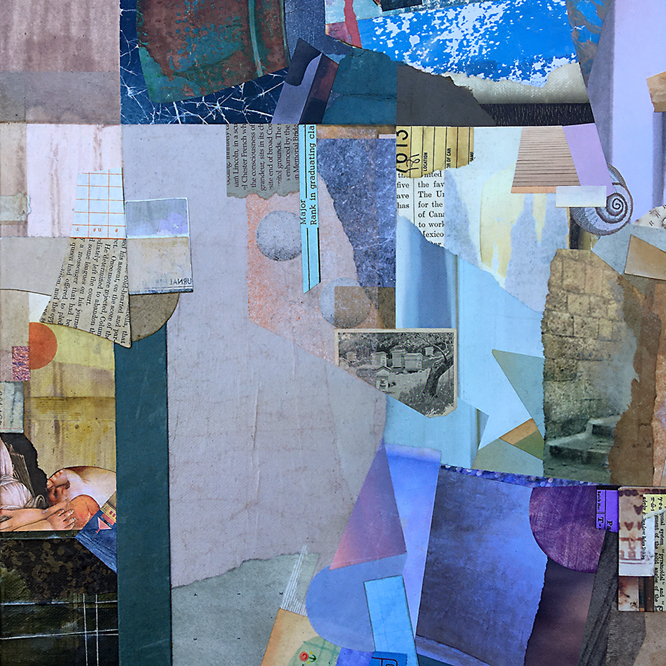
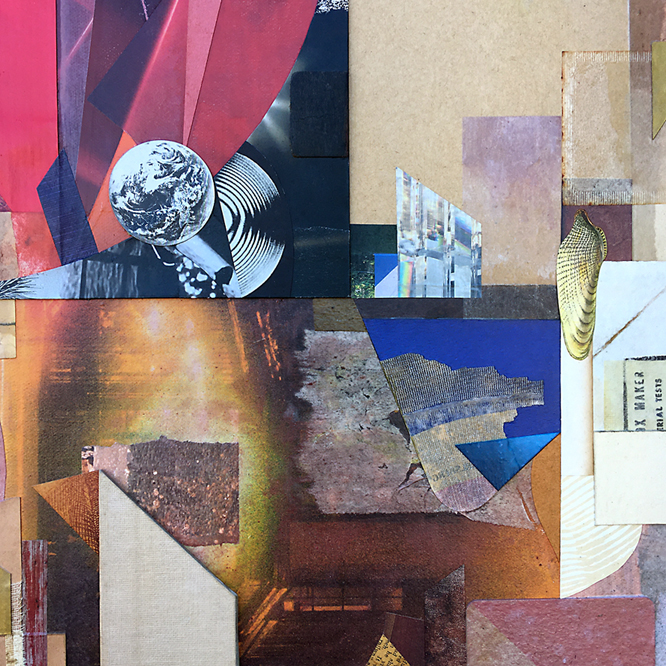
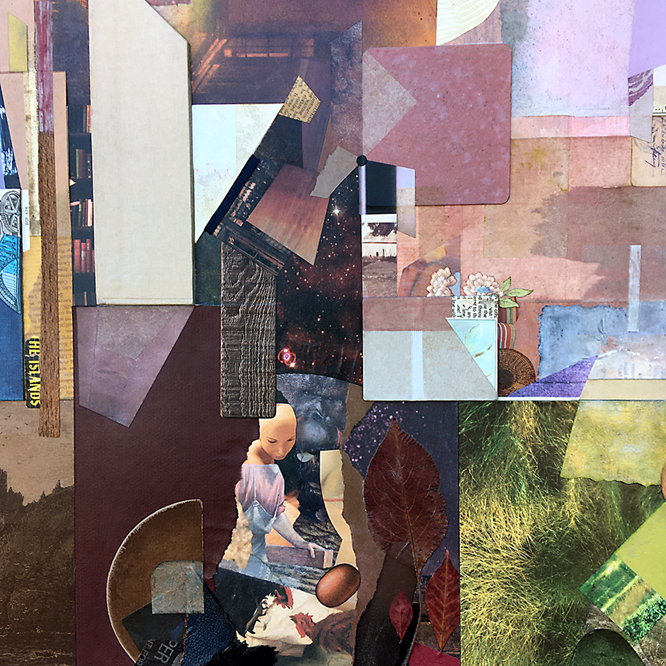
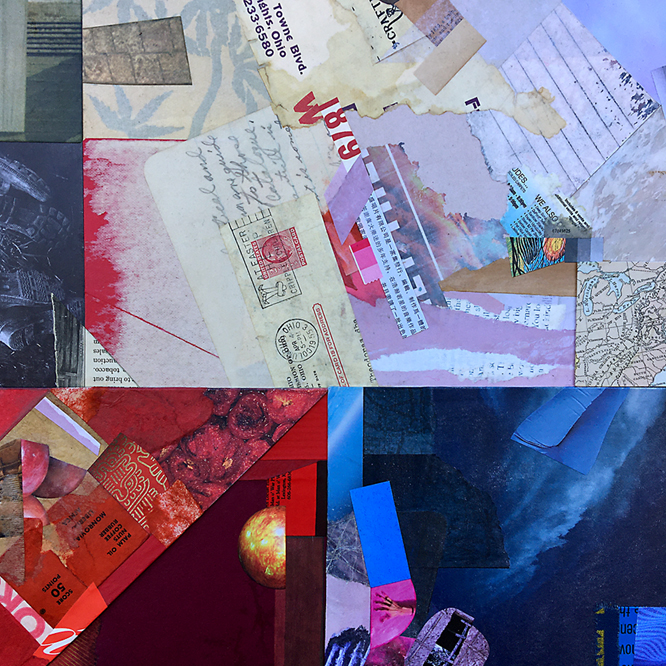
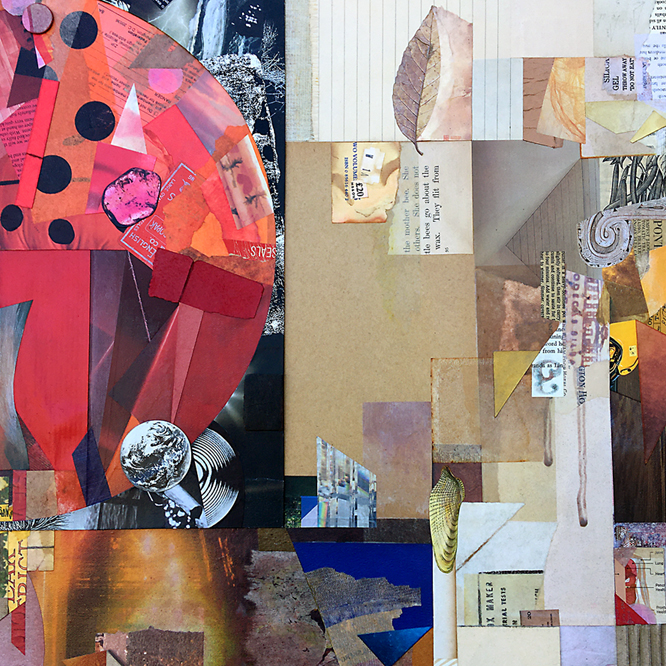

Synthesis (six details for study)
collage on canvas by J A Dixon
48 x 36 inches
available for purchase
Posted in 1) Available!, Abstraction, Collage, Criticism, Details, Ingredients, J A Dixon, Larger Works, Merz, Methodology | No Comments »
Friday, January 29th, 2021
“Improvising is the closest thing I do to meditation. I have to respond honestly to what’s happening in the music.”
— Michelle Dorrance
“Order is not enough. You can’t just be stable, and secure, and unchanging, because there are still vital and important new things to be learned. Nonetheless, chaos can be too much. You can’t long tolerate being swamped and overwhelmed beyond your capacity to cope while you are learning what you still need to know. Thus, you need to place one foot in what you have mastered and understood and the other in what you are currently exploring and mastering.”
— Jordan B Peterson
The year culminated in my largest collage artwork so far. I’m pleased to announce its acceptance as part of REVEAL, a new display of large-scale, two-dimensional pieces in the Kentucky Artisan Center at Berea. All of us might point to a milestone achievement. It can be the most effortless and the most challenging thing we’ve ever done, both at the same time.
Buried in a twelve-month cycle of worldwide catastrophe are countless stories to be told by artists who crossed the treacherous, often surreal territory of 2020. Perhaps they are less significant than what so many others endured, often within tragic circumstances, but creative people have had to face unprecedented disruptions like everyone. Restrictions under pandemic transformed many aspects of individual practices. I am very fortunate to have been able to continue working in the same isolated way characteristic of my long tenure from a home-based studio. Our regional plein air group managed to stay active. Artistic cross pollination flourished online. Opportunities for me to show art remained intact — all because many persevered to organize exhibitions that might have been conveniently postponed or canceled. Each person on that list overcame hurdles to make things happen, and to develop virtual adjuncts that held risks to a minimum.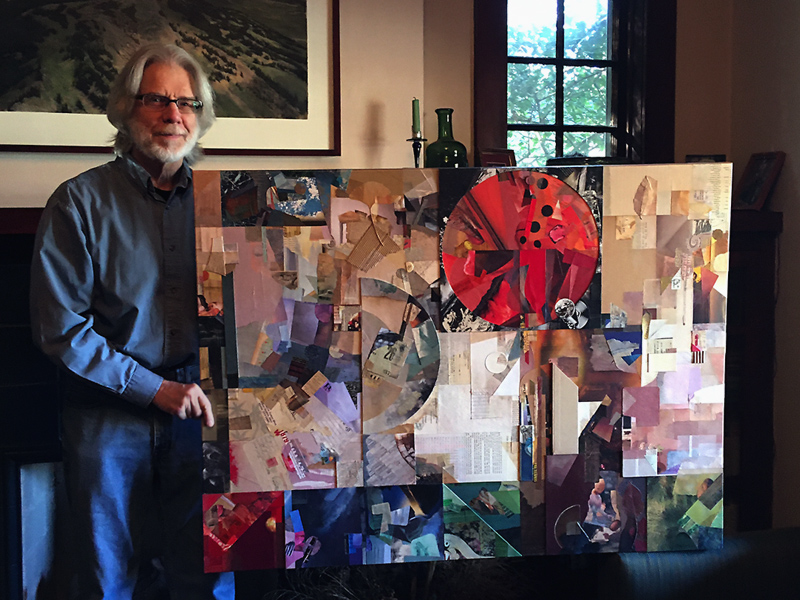 Amid the frustrating chaos, there are many things for which to be thankful.
Amid the frustrating chaos, there are many things for which to be thankful.
As I’ve described here before, my experimental miniatures have been the basis for larger works on canvas. Decades of design decisions and influences enable my work to be intuitive in process. In late 2020, I challenged myself to take what I’ve discovered with explorations at a smaller scale and to formalize it as a merger of design structure and pure spontaneity. Within a large format, I can focus on a counterbalance of both. Synthesis is an example of this fusion.
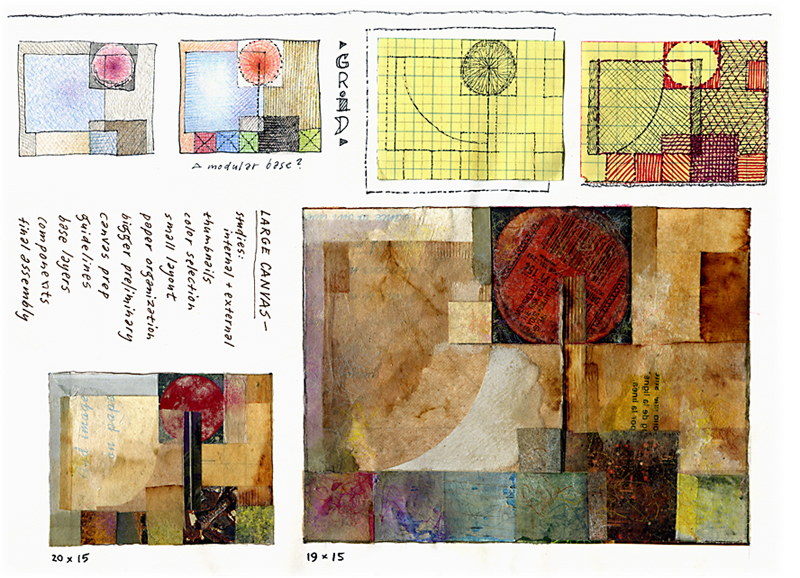 For me, collage abstraction is about the creative tension between order and chaos, comparable to how a soloist elaborates extemporaneously on a written melody. The characteristics of the paper ingredients — color, value, shape, line, texture — serve as the notes, rests, and rhythms of the composition. Thumbnail studies represent the evolution of a “manuscript,” analogous to musical notation, which then allows for an improvisational “performance.” But unlike a live concert, the visual artist can choose to return to a spontaneous expression and make deliberate refinements before declaring a piece “finished.” If so, it becomes similar to layering or enhancing tracks in a recording studio as the last step in a process. My bringing a large artwork to completion in this manner stands in contrast to the making of collage miniatures. There is a strong connection between the two rituals that I shall continue to explore.
For me, collage abstraction is about the creative tension between order and chaos, comparable to how a soloist elaborates extemporaneously on a written melody. The characteristics of the paper ingredients — color, value, shape, line, texture — serve as the notes, rests, and rhythms of the composition. Thumbnail studies represent the evolution of a “manuscript,” analogous to musical notation, which then allows for an improvisational “performance.” But unlike a live concert, the visual artist can choose to return to a spontaneous expression and make deliberate refinements before declaring a piece “finished.” If so, it becomes similar to layering or enhancing tracks in a recording studio as the last step in a process. My bringing a large artwork to completion in this manner stands in contrast to the making of collage miniatures. There is a strong connection between the two rituals that I shall continue to explore.
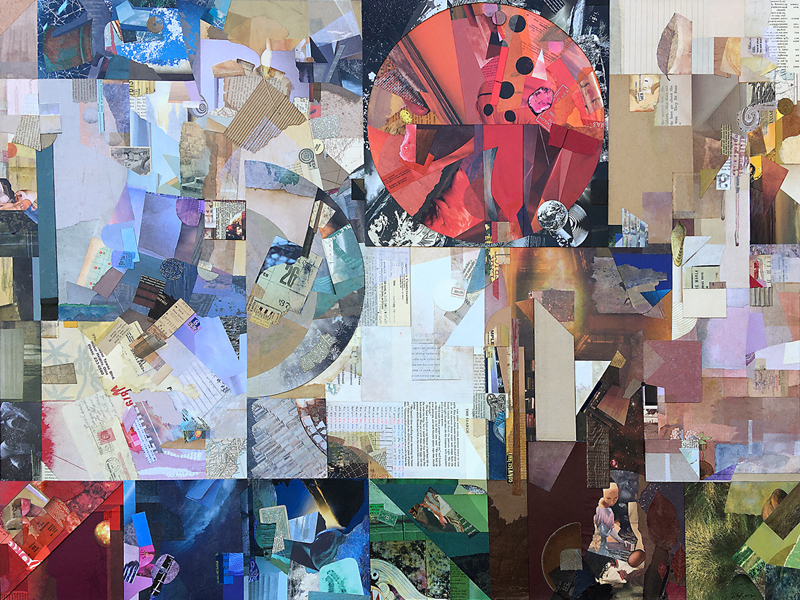
Synthesis
collage on canvas by J A Dixon
48 x 36 inches
available to collectors
Posted in 1) Available!, Abstraction, Collage, Embedded Miniatures, Exhibitions, J A Dixon, Larger Works, Methodology, Music, Thumbnails | No Comments »
Thursday, September 17th, 2020
“Our highest assurance of the goodness of Providence seems to me to rest in the flowers. All other things, our powers, our desires, our food, are all really necessary for our existence in the first instance. But this rose is an extra. Its smell and its color are an embellishment of life, not a condition of it. It is only goodness which gives extras, and so I say again that we have much to hope from the flowers.”
― Arthur Conan Doyle
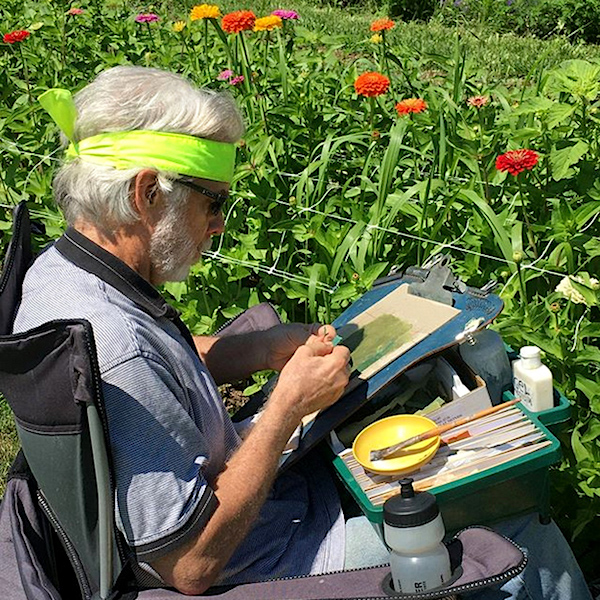
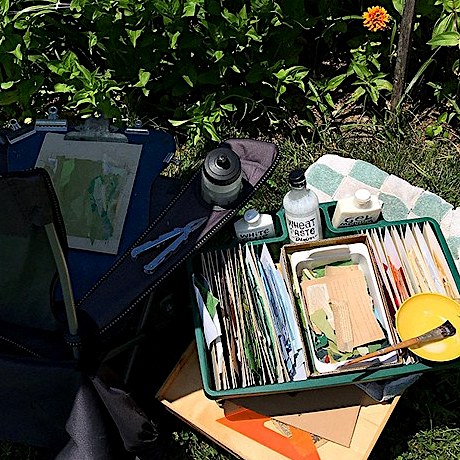
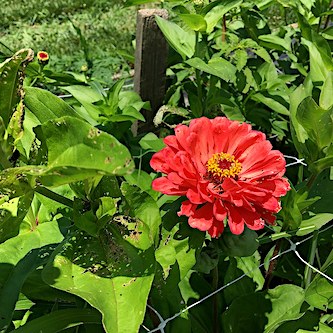
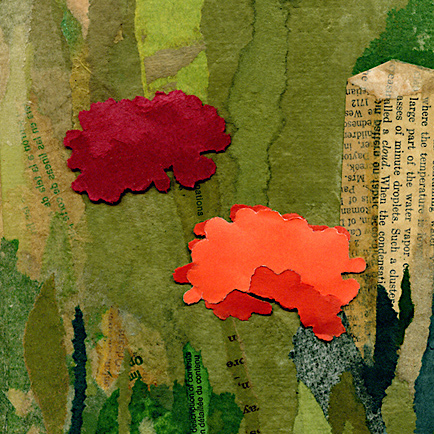
(clockwise, from top left) Working at the sunny flowerbed in July. The ‘rig’ that enables me to take the medium of collage outside. The result of my concentrated, on-site attention. Closeup of a marvelous bloom that cast its spell on me.
My thanks to Margo and Russ Goodwin for their purchase during our annual exhibition, En Plein Air. Your sunny garden in July was a perfect spot to paint flowers, which I’d never done with paper before. My appreciation to Donna F for her continuous encouragement, to Katherine W for getting a shot of me with that rig I developed to create collage outdoors, and to Amanda G for taking pity on me with the loan of her handy umbrella. The last image in the grid above is the result of my preliminary work at the flowerbeds — to get a roughly seven-inch square composition. Needless to say, all the time spent studying the surrounding zinnias resulted in minimal pasted paper for the actual blossoms, but stored memories and photo references were sufficient to prime an expressive treatment back in the studio.
As I’ve mentioned before, my objective is to spend fewer hours with the indoor follow-up than I do on location. I’ll usually require “half-and-half” to resolve a solution. Yes, there are those who wouldn’t accept that as a legitimate plein-air piece. It’s a standard cut-off point that we use for our PAACK. It works well for me at this stage of my learning to “paint in papers.” The more important aspect of this journey into natural settings is the clear sense that contemporary collage, an innovation by modern-art painters, may still be largely untapped as a method of visually interpreting the observed world, especially as part of the plein air tradition. Flowers should be a essential part of that adventure.
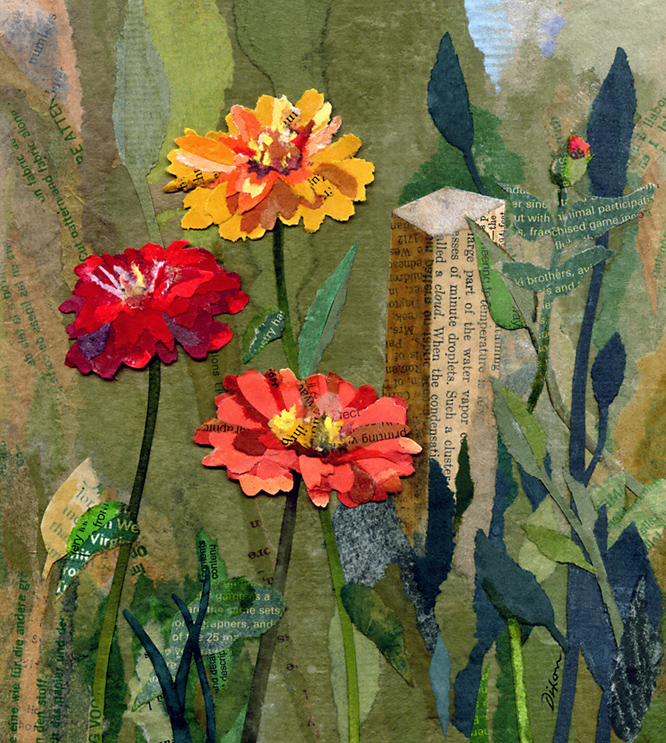
July Zinnias
plein air collage miniature by J A Dixon
50% /50% — site to studio
6.375 x 7.3125 inches
• S O L D
Posted in En Plein Air, J A Dixon, Methodology | No Comments »
Saturday, August 22nd, 2020
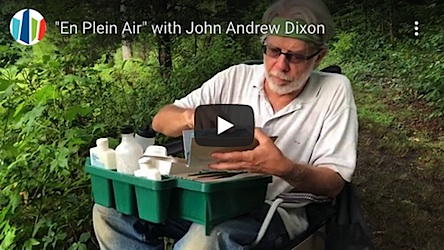
“You can decide that you want your art to be very close, exacting, and faithful to the scene, or you can just let nature charge your imagination, and you just go from there.”
— from our video “ridealong”
It turned out to be one of the more memorable days of the summer — not just another opportunity to take my collage making to a natural place, but a collaborative effort with my friend Brandon Long from Art Center of the Bluegrass. Responding to the new demands of the era, he was in the middle of organizing a virtual field trip to dovetail with our annual En Plein Air exhibition. He wants to encourage youngsters to create collage artwork out of doors, so he asked me if I would be the subject of a short video. Our local PAACK had already scheduled an event at Central Kentucky Wildlife Refuge, but, with the likelihood of rain, 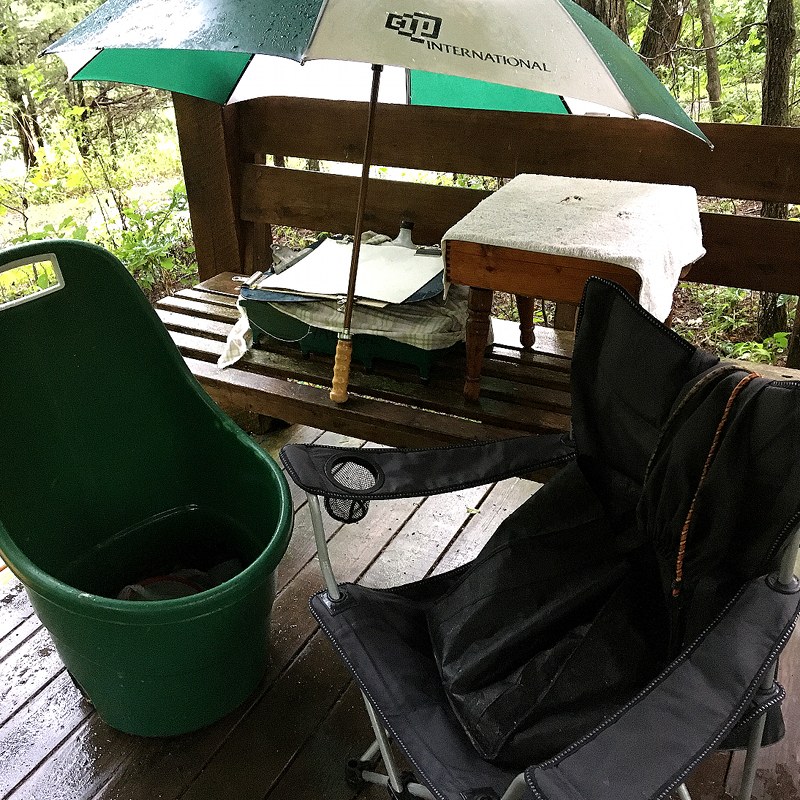
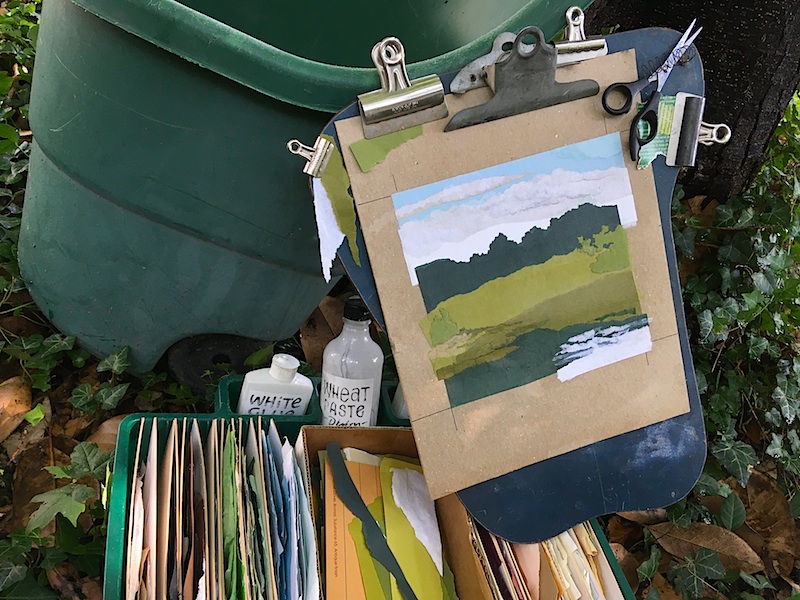
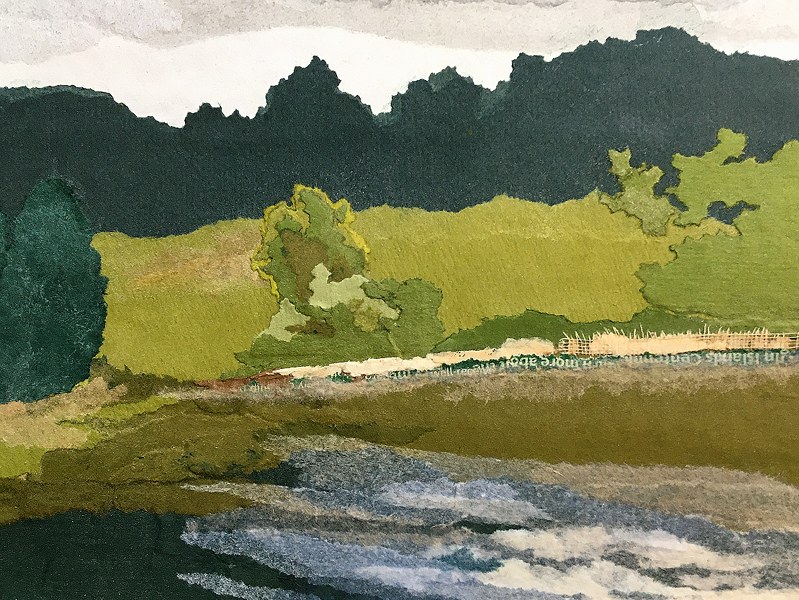 the gathering had been postponed earlier that morning. Brandon and I felt lucky, and we pushed ahead with the outing anyway. We were successful in avoiding the poison ivy and pulling off our little production at the edge of Island Pond. Not much later, a thunderstorm sent me skedaddling beneath a nearby shelter. Somehow, I came away with a good start on a miniature that I could finish in the studio. My goal has always been to spend less time with the indoor follow-up than I spend on location. Sometimes it happens, but usually I need a 50/50 time ratio between site and studio to bring something to a satisfactory resolution. There are artists who would not consider that a legitimate plein-air solution. It’s a standard limitation that we use for our Central Kentucky group. At any rate, I find the entire process to be personally rewarding. If I keep doing this, I think that basically I’ll get to where I can complete something in the field. Meanwhile, the challenge is to “paint with paper,” capturing the essence of a viewscape on site, and then to avoid messing that up with my finishing touches.
the gathering had been postponed earlier that morning. Brandon and I felt lucky, and we pushed ahead with the outing anyway. We were successful in avoiding the poison ivy and pulling off our little production at the edge of Island Pond. Not much later, a thunderstorm sent me skedaddling beneath a nearby shelter. Somehow, I came away with a good start on a miniature that I could finish in the studio. My goal has always been to spend less time with the indoor follow-up than I spend on location. Sometimes it happens, but usually I need a 50/50 time ratio between site and studio to bring something to a satisfactory resolution. There are artists who would not consider that a legitimate plein-air solution. It’s a standard limitation that we use for our Central Kentucky group. At any rate, I find the entire process to be personally rewarding. If I keep doing this, I think that basically I’ll get to where I can complete something in the field. Meanwhile, the challenge is to “paint with paper,” capturing the essence of a viewscape on site, and then to avoid messing that up with my finishing touches.
https://artcenterky.org/2020/08/creating-collage-en-plein-air/
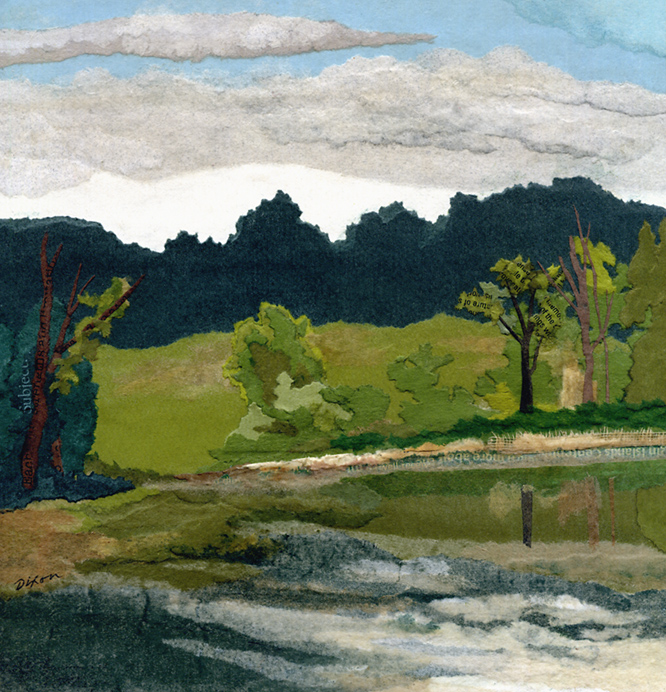
Before a Storm
plein air collage miniature by J A Dixon
50% / 50% — site to studio
7.5 x 7.8125 inches
available for purchase
Posted in 1) Available!, B Long, Collaboration, Collage, Demonstrations, En Plein Air, Experiments, J A Dixon, Landscape, Methodology, Technique, Video | No Comments »
 Dream-inspired images are rare creatures for me, but I grab one when it emerges. More often than not, my waking imagination falls short when trying to capture it. Over the years, I’ve had more success in that line coming up with graphic design concepts than I have with artistic impressions. It probably has something to do with how my subconscious responds to an explicit problem-solving setup, in contrast to more undefined visual images (which in my dreams tend to be preposterously complicated and nearly impossible to retain).
Dream-inspired images are rare creatures for me, but I grab one when it emerges. More often than not, my waking imagination falls short when trying to capture it. Over the years, I’ve had more success in that line coming up with graphic design concepts than I have with artistic impressions. It probably has something to do with how my subconscious responds to an explicit problem-solving setup, in contrast to more undefined visual images (which in my dreams tend to be preposterously complicated and nearly impossible to retain). but they usually don’t grasp the full picture. A refined trust in intuition is often mistaken for talent, but actual talent is a creation of the Universal Source. Artistic talent, intellectual talent, empathic talent, athletic talent — there is no difference, because we all get our start with some kind of talent as a divine inheritance. For some of us, it might’ve been more obvious (especially if we liked to show off for others). How many “talented” young athletes are age-group champions into later life? How many “talented” young musicians or dancers become professional performers with the respect of their peers? There you have it. Any talent can be lost without the effort and stick-to-it mindset that overcomes challenges and builds effective skills and attitudes. And make no mistake about it — such acquired discipline comes from God, too, so let’s give proper credit and keep working!
but they usually don’t grasp the full picture. A refined trust in intuition is often mistaken for talent, but actual talent is a creation of the Universal Source. Artistic talent, intellectual talent, empathic talent, athletic talent — there is no difference, because we all get our start with some kind of talent as a divine inheritance. For some of us, it might’ve been more obvious (especially if we liked to show off for others). How many “talented” young athletes are age-group champions into later life? How many “talented” young musicians or dancers become professional performers with the respect of their peers? There you have it. Any talent can be lost without the effort and stick-to-it mindset that overcomes challenges and builds effective skills and attitudes. And make no mistake about it — such acquired discipline comes from God, too, so let’s give proper credit and keep working!




































